 W
WThe coat of arms of the Autonomous Republic of Adjara is a shield divided in two by a wavy line. In the center is a red smaller shield of the Lesser Arms of Georgia, bearing a silver horseman with a golden halo mounted on a silver horse and slaying a silver dragon with a golden-tipped, silver-shafted spear. The upper sector of the main shield bears a golden fortress on a green field and the lower one contains three golden coins on blue field.
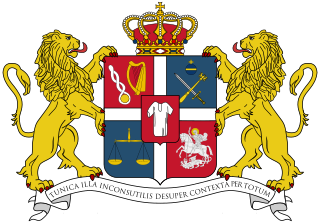 W
WThe coat of arms of the Bagrationi dynasty has been used by the former royal family of Georgia and its descendants. It is a symbol of the Bagrationi dynasty, which claims the erstwhile Georgian crown.
 W
WThe coat of arms of the city of Bamberg shows Saint George.
 W
WThe coat of arms of the British Virgin Islands consists of a green escutcheon (shield) charged with a woman in a white dress and gold-coloured sandals, holding a lit golden oil lamp and surrounded by eleven other golden lamps. Adopted shortly after the islands became a Crown colony, it has been the coat of arms of the British Virgin Islands since 1960. The escutcheon dates from the early 19th century and is featured on the flag of the territory. The woman and the lamps represent Saint Ursula and her companions, the namesake of the islands.
 W
WThe coat of arms of Bucharest is the heraldic symbol of the capital city of Romania. The present-day coat of arms was adopted by Domnitor Alexandru Ioan Cuza, and changed under the Communist regime. In 1994, it was renewed again with minor alterations.
 W
WThe coat of arms of Cantabria has a rectangular shield, round in base and the field is party en fess. In field azure, a tower or crenellated and masoned, port and windows azure, to its right a ship in natural colours that with its bow has broken a chain sable going from the tower to the dexter flank of the shield. At the base, sea waves argent and azure, all surmounted in chief by two male heads, severed and haloed. In field gules, a disc-shaped stele with geometric ornaments of the kind of the Cantabrian steles of Barros or Lombera. The crest is a closed royal crown, a circle of jeweled gold, made up of eight rosettes in the shape of acanthus leaves, only five visible, interpolated with pearls, and with half-arches topped with pearls raising from each leaf and converging in an orb azure, with submeridian and equator or, topped with cross or. The crown, covered in gules.
 W
WThe coat of arms of Georgia is one of the national symbols of the republic. It is partially based on the medieval arms of the Georgian royal house and features Saint George, the traditional patron saint of Georgia. In addition to St. George, the original proposal included additional heraldic elements found on the royal seal, such as the seamless robe of Jesus, but this was deemed excessively religious and was not incorporated into the final version.
 W
WThe coat of arms of Głogów depicts a shield divided crosswise into four fields, with a fifth central field on which there appears in the centre an initial golden "G" on a red background.
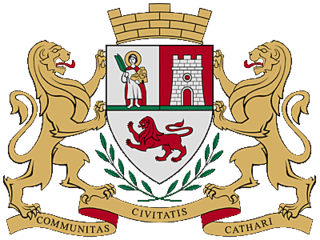 W
WThe coat of arms of Kotor is an official insignia of Kotor, coastal town in Montenegro. This is a new Coat of Arms, adopted on 16 February 2009. It is designed by Srđan Marlović, who also designed the Coat of arms of Podgorica and that of Bar.
 W
WThe coat of arms of Lubawa in the Warmian-Masurian Voivodeship, Poland, depicts a bishop of Chełmno or Culm, generally identified as the first bishop, Christian of Oliva, with his right hand raised in benediction. He stands between a lime tree and a fir tree.
 W
WThe coat of arms of Miskolc, Hungary was created in 1909 based on the mediaeval seals of the city.
 W
WThe coat of arms of Moscow depicts a horseman with a spear in his hand slaying a basilisk and is identified with Saint George and the Dragon. The heraldic emblem of Moscow has been an integral part of the coat of arms of Russia since the 16th century.
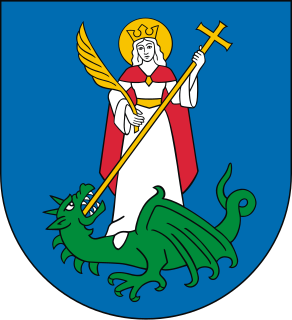 W
WThe coat of arms of Nowy Sącz in Poland shows Saint Margaret the Virgin, depicting the legend that she was swallowed by Satan, in the form of a dragon, who was however forced to spit her out again because the cross she was carrying irritated the dragon's innards. In Margaret's other hand is an olive branch, a symbol of peace.
 W
WThe coat of arms of Nowy Targ, a town in southern Poland, depicts the martyr Saint Catherine of Alexandria dressed in white with a red cape with white stars, wearing a gold crown. She holds a sword at her side and a palm leaf. She stands in front of a gold Catherine wheel. Her head is encircled by a halo, indicating her sainthood.
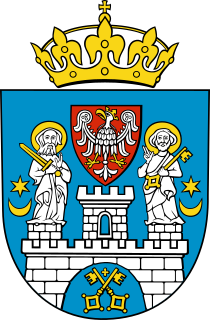 W
WThe coat of arms of Poznań consists of white city walls with three towers. On the left (heraldic) tower stands Saint Peter with a key and on the heraldic right one stands Saint Paul with a sword. In the gate there are two golden crossed keys with a cross above. Over the middle tower, which contains a single window and is topped by a battlement, there is a gothic shield with a white eagle in crown. On the sides of the two saints there are golden crescents and stars. All of those elements are on a blue field. Over the shield there is golden crown. Author of modern version of coat of arms is Jerzy Bąk.
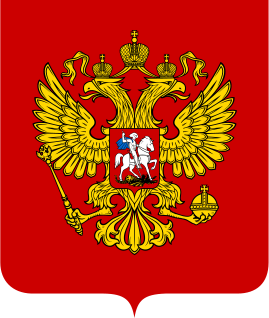 W
WThe coat of arms of Russia derives from the earlier coat of arms of the Russian Empire which was abolished with the Russian Revolution in 1917. Though modified more than once since the reign of Ivan III (1462–1505), the current coat of arms is directly derived from its medieval original, with the double-headed eagle having Byzantine and earlier antecedents. The general tincture corresponds to the early fifteenth-century standard.
 W
WSelje is a former municipality in the county of Sogn og Fjordane, Norway. It was located in the traditional district of Nordfjord. The village of Selje was the administrative center of the municipality.
 W
WThe Coat of arms of Split is the heraldic symbol of the city of Split, in use since at least the Middle Ages. It consists of a rectangular escutcheon (shield), featuring a part of the northern walls of Diocletian's Palace, as they appeared in the Medieval period. In the middle, above the walls, is the belfry of the Cathedral of Saint Domnius. In the upper corners are two shields, to the left (dexter) the historical coat of arms of Croatia, and right (sinister) a shield picturing the town's patron, Saint Domnius. The coat of arms is bordered with Gothic rectangles, which represent the walls of the Palace.
 W
WThe coat of arms of Stockholm depicts the head of Swedish king Saint Eric. It was first used in medieval seals.
 W
WCoat of arms of Vilnius is the coat of arms of the city of Vilnius, Lithuania. It is also used as coat of arms of Vilnius city municipality. The modern version was created in 1991 by Arvydas Každailis, the same artist who drew the modern coat of arms of Lithuania. The design is based on the oldest seals of the Vilnius City Council dating back to the 14th century.
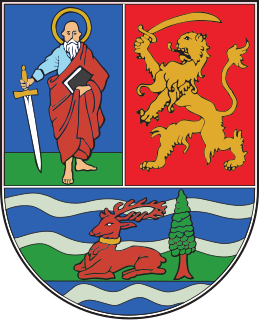 W
WThere are two coats of arms in official use in the Autonomous Province of Vojvodina, the Coat of arms of Vojvodina and the Traditional coat of arms of Vojvodina. Two coats of arms are given the equal status in the Provincial Assembly Decision on the Appearance and Usage of Symbols and Traditional Symbols of AP Vojvodina adopted in 2016.
 W
WThe coat of arms of the City of Wrocław is divided into quarters. It dates back to 1530, when it was approved by Emperor Charles V.